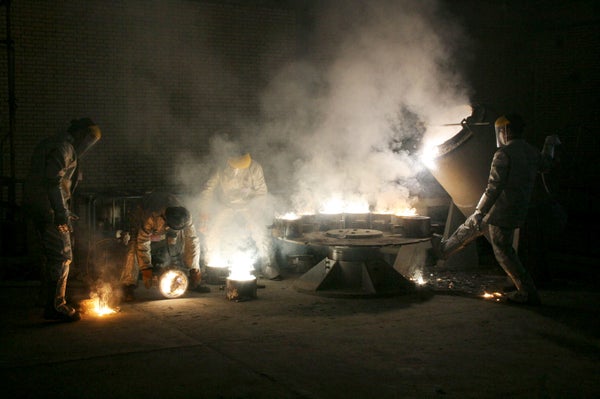Might Iran Have Been Near Making a Nuclear Weapon? Uranium Enrichment Defined
When Israeli plane lately struck a uranium-enrichment advanced within the nation, Iran might have been days away from attaining “breakout,” the flexibility to shortly flip “yellowcake” uranium into bomb-grade gas, with its new high-speed centrifuges

Males work inside a uranium conversion facility simply exterior town of Isfahan, Iran, on March 30, 2005. The power in Isfahan made hexaflouride gasoline, which was then enriched by feeding it into centrifuges at a facility in Natanz, Iran.
Within the predawn darkness on Friday native time, Israeli army plane struck one in every of Iran’s uranium-enrichment complexes close to town of Natanz. The warheads aimed to do greater than shatter concrete; they had been meant to purchase time, in line with information stories. For months, Iran had gave the impression to be edging ever nearer to “breakout,” the purpose at which its rising stockpile of partially enriched uranium might be transformed into gas for a nuclear bomb. (Iran has denied that it has been pursuing nuclear weapons growth.)
However why did the strike happen now? One consideration might contain the best way enrichment complexes work. Pure uranium consists nearly totally of uranium 238, or U-238, an isotope that’s comparatively “heavy” (that means it has extra neutrons in its nucleus). Solely about 0.7 % is uranium 235 (U-235), a lighter isotope that’s able to sustaining a nuclear chain response. That implies that in pure uranium, solely seven atoms in 1,000 are the lighter, fission-ready U-235; “enrichment” merely means elevating the proportion of U-235.
U-235 can be utilized in warheads as a result of its nucleus can simply be break up. The Worldwide Atomic Vitality Company makes use of 25 kilograms of contained U-235 because the benchmark quantity deemed adequate for a first-generation implosion bomb. In such a weapon, the U-235 is surrounded by standard explosives that, when detonated, compress the isotope. A separate gadget releases a neutron stream. (Neutrons are the impartial subatomic particle in an atom’s nucleus that provides to their mass.) Every time a neutron strikes a U-235 atom, the atom fissions; it divides and spits out, on common, two or three contemporary neutrons—plus a burst of vitality within the type of warmth and gamma radiation. And the emitted neutrons in flip strike different U-235 nuclei, making a self-sustaining chain response among the many U-235 atoms which have been packed collectively right into a important mass. The result’s a nuclear explosion. In contrast, the extra widespread isotope, U-238, normally absorbs sluggish neutrons with out splitting and can’t drive such a devastating chain response.
On supporting science journalism
When you’re having fun with this text, take into account supporting our award-winning journalism by subscribing. By buying a subscription you’re serving to to make sure the way forward for impactful tales in regards to the discoveries and concepts shaping our world at the moment.
To complement uranium in order that it accommodates sufficient U-235, the “yellowcake” uranium powder that comes out of a mine should undergo a prolonged technique of conversions to remodel it from a strong into the gasoline uranium hexafluoride. First, a sequence of chemical processes refine the uranium after which, at excessive temperatures, every uranium atom is sure to 6 fluorine atoms. The end result, uranium hexafluoride, is uncommon: under 56 levels Celsius (132.8 levels Fahrenheit) it’s a white, waxy strong, however simply above that temperature, it sublimates right into a dense, invisible gasoline.
Throughout enrichment, this uranium hexafluoride is loaded right into a centrifuge: a steel cylinder that spins at tens of hundreds of revolutions per minute—sooner than the blades of a jet engine. Because the heavier U-238 molecules drift towards the cylinder wall, the lighter U-235 molecules stay nearer to the middle and are siphoned off. This new, barely U-235-richer gasoline is then put into the following centrifuge. The method is repeated 10 to twenty instances as ever extra enriched gasoline is distributed via a sequence of centrifuges.
Enrichment is a sluggish course of, however the Iranian authorities has been engaged on this for years and already holds roughly 400 kilograms of uranium enriched to 60 % U-235. This falls in need of the 90 % required for nuclear weapons. However whereas Iran’s first-generation IR-1 centrifuges whirl at about 63,000 revolutions per minute and do comparatively modest work, its newer IR-6 fashions, constructed from high-strength carbon fiber, spin sooner and produce enriched uranium much more shortly.
Iran has been putting in hundreds of those models, particularly at Fordow, an underground enrichment facility constructed beneath 80 to 90 meters of rock. Based on a report launched on Monday by the Institute for Science and Worldwide Safety, the brand new centrifuges might produce sufficient 90 % U-235 uranium for a warhead “in as little as two to 3 days” and sufficient for 9 nuclear weapons in three weeks—or 19 by the tip of the third month.


